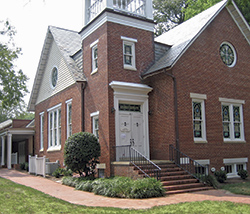A Place to Call Their Own
New Graduate Student Center opens doors

From a psychology student analyzing the social functioning of schizophrenics, to a neurobiologist finding a direct link between alcoholism and depression in lab mice, to a playwright penning and performing plays to inspire African-American youths, the work of graduate students contributes significantly to Carolina’s reputation as a leading research university. Their work connects people and leads to greater understanding.
Yet graduate students are often isolated within their own departments across campus. Perhaps the sense of community that seems to flow naturally for undergraduates in college takes more effort to achieve when there are more responsibilities and a greater focus on specialized areas of study.
“When you’re an undergrad, you’re still trying to figure things out. You also have more time. So you socialize, join organizations and groups, and overall just get together more often,” says Maya Mateshvilli, a second-year master’s student in Journalism and Mass Communications. “As a graduate student, on the other hand, you might have a family to take care of. You’re paying your own rent and utilities. You’re also more likely to know what you want academically and thus focus more of your energy on that.”
For graduate students at Carolina to thrive, however, interaction with other students is still essential. Graduate School Dean Linda Dykstra says that while graduate students get various opportunities to interact within their respective departments, they benefit further from a centralized location that cultivates academic and social interaction.
“Graduate students needed a place that would be ideal for seminars, symposiums and fellowship activities. By sharing what they are working on with each other, they’re able to get feedback, and the learning environment becomes even more dynamic, synergistic and productive,” Dykstra says. “It’s also good for them to have a place to meet with other students and socialize.”
Dykstra says that the idea for a Graduate Student Center originally came from the late Henry Dearman, a former dean of the Graduate School and member of the Graduate Education Advancement Board. Graduate School officials worked with the Graduate and Professional Student Federation and the Provost’s Office for a number of years to establish a Graduate Student Center on campus.
Finally, in January 2005, the Graduate Student Center opened its first temporary location above the Carolina Coffee shop on Franklin Street. Reception was good, but its lack of accessibility and size limited its use.
Thus in September 2007, Dykstra was thrilled to open the doors to a new Graduate Student Center on 211 W. Cameron Avenue, just beyond the Carolina Inn. The Graduate Student Center’s new location immediately increased student participation.
Since its opening, the Graduate Student Center has been the venue for several orientations and symposiums. Departments and organizations such as the School of Government, the Carolina Women’s Center and the Minority Recruitment and Retention Committee have held meetings, networking forums and panel discussions there and students have held social gatherings.
Bryan Rybarczyk, Director of Graduate Student Academic and Professional Development, says that the new Graduate Student Center, at 2,800 square feet, offers much more space. It can accommodate up to 70 people during seminars and 150 people during receptions. The building is also handicapped-accessible, says Lauren Anderson, president of the Graduate and Professional Student Federation, and it does not charge students for the use of equipment or for bringing in food.
As graduate students develop, they will always have to focus primarily on their own study and research. But thanks to the new Graduate Student Center, they now have a place where they can interact with and learn from others. • Margarita De Pano


